VIA's Dual Core Nano & VN1000 Chipset Previewed
by Anand Lal Shimpi on November 15, 2010 12:26 PM ESTGraphics Performance: Surprisingly Potent
Preparing to test the VN1000 was a lot like deciding to go see a John Cusack movie. You assume it’s going to be bad, but every now and then you might be pleasantly surprised. My expectations were thus very low.
The last VIA platform I had wouldn’t complete most 2D benchmarks in Windows 7 due to driver issues and general instability. That’s why you only see a few scores from the old Nano in Bench. The VN1000 was completely different.
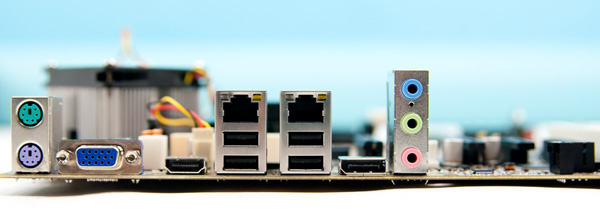
The VIA VN1000 Reference Board featured VGA, HDMI and DP outputs
Despite the typical omg-thisisntATI/NVIDIA error that some games always throw, the VN1000 actually ran everything I threw at it. I didn’t notice any rendering errors or any driver compatibility problems. I didn’t run every last title on the market, but I ran a number that I honestly didn’t expect VIA to be able to handle. And the VN1000 did.
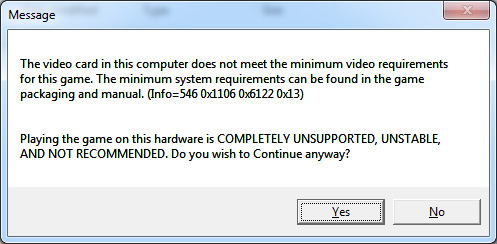
Dragon Age, Modern Warfare 2, BioShock 2, World of Warcraft and even Starcraft II all ran on the VN1000. Not only did they run, but some of them actually ran pretty well.
As with all integrated graphics I had to test at the lowest possible quality settings at 1024 x 768 across virtually all titles. I should add that although the Chrome 520 GPU does support H.264 acceleration, I couldn't get it working with the driver drop I had on my test platform. CPU utilization would be low but I still dropped frames. I suspect this is a driver or software compatibility issue which I do expect VIA to rectify before the platform ships.
First let’s compare directly to Atom and ION:
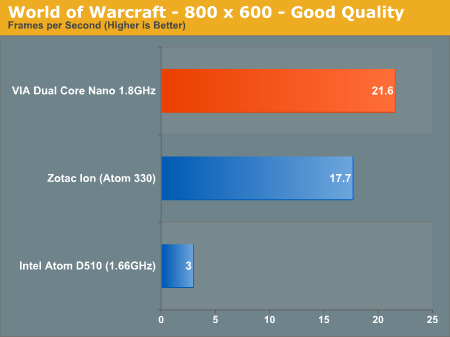
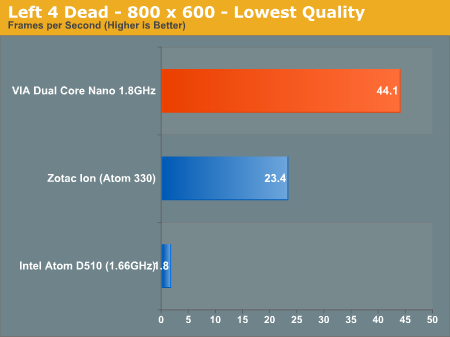
The Atom comparison is dramatic. Intel hasn’t taken GPU performance seriously for years and Atom was the last example of that mentality. What’s even more surprising however is that the Chrome 520 GPU is actually faster than NVIDIA’s ION.
Clearly the VN1000 can hold its own in the Atom space, so let’s set our sights a little higher. How about Clarkdale?
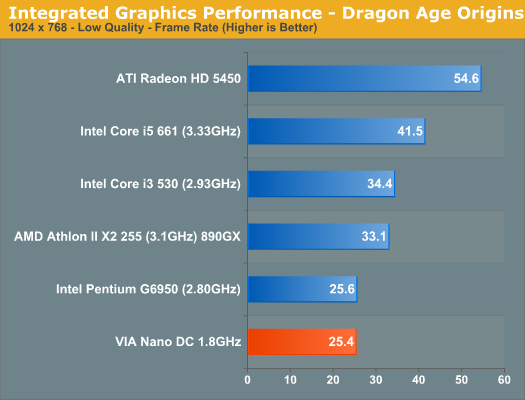
Under Dragon Age Clarkdale puts VIA in its place. The Core i3 manages a 40% performance advantage here. But look at a lower end competitor: the Pentium G6950 is no faster than the dual core Nano/VN1000 platform!
It gets even more ridiculous under Modern Warfare 2:
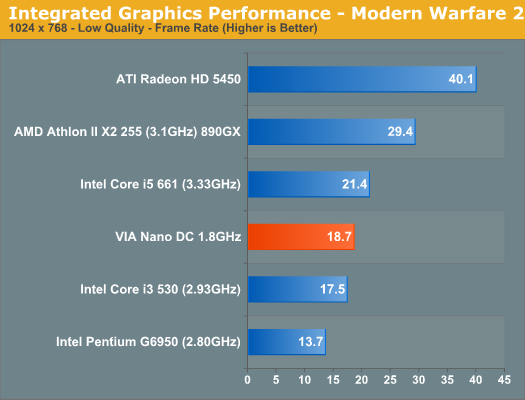
VIA’s platform is actually faster than Intel’s Core i3 with integrated graphics. The same holds true under World of Warcraft:

Here the Nano is able to even equal the performance of the Core i5 661. Pretty impressive.
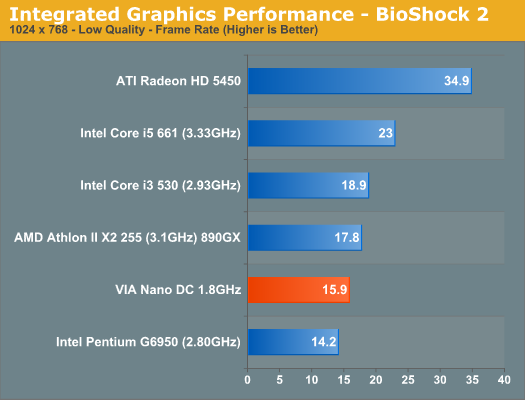
The VIA platform didn't handle BioShock 2 very well, but it's still able to get the Pentium G6950 a run for its money.
I was particularly curious to see how Starcraft II ran on the platform. Starcraft II can be both GPU and CPU limited within a single play session simply depending on what you're doing. Scrolling around the map and just watching your units gather resources tends to be GPU bound on mainstream or faster systems. Big battles however are almost always CPU bound. To showcase both we have two benchmarks. Our GPU test is a 2v2 with a lot of scrolling around the map, while our CPU test is a 3v3 monitoring frame rate during a huge battle involving all of the players.
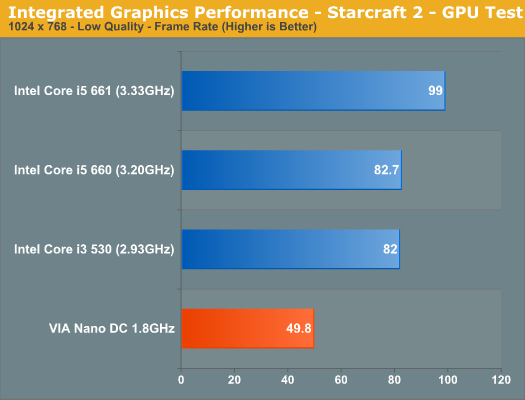

VIA's Chrome 520 is definitely fast enough for Starcraft II. At low quality settings, the VIA platform can manage nearly 50 fps in our GPU test. That translates into smooth gameplay while moving around a map and selecting units. It's the CPU that's holding back the platform. In large battles the Nano DC drops down below 10 fps and choppiness ensues. Intel's Clarkdale graphics enjoys around 2x the performance in our CPU test and about 60% higher frame rates in the GPU test. Intel has done a lot of work with Blizzard optimizing for SC2, so strong performance here isn't surprising.
Overall, you can color me impressed. This is real world, usable performance. Even the experience under Windows wasn’t half bad. Moving windows around was sometimes choppy but for the most part it could’ve been any other integrated graphics platform that I was using. Drivers installed fine and I didn’t get any strange crashes or compatibility errors during my limited testing period.
I have to say that this is probably the first VIA platform that has delivered not only competitive but impressive graphics performance in years. Let’s take a look at the CPU performance.










54 Comments
View All Comments
LoneWolf15 - Tuesday, November 16, 2010 - link
I still have an MSI KT4-VL (KT400 chipset) on my workbench that was in my parent's system. For over five years without complaint it ran an Athlon XP-M (Barton) 2500+ clocked at 2.3GHz in their system, and it still runs fine.Graphics aside, VIA's chipsets have been solid over the years, as long as a reliable vendor built the mainboards. Trouble is, lots of VIA chipsets were bought by companies like ECS to build budget mainboards. The chipsets weren't the problem, but the manufacturing process and quality control gave the boards reputations, and VIA an undeserved black eye along with it. When someone like ASUS or MSI made a VIA board, it always turned out just fine.
Snotling - Tuesday, November 16, 2010 - link
The black eye was totally deserved, mostly for all the bad rep their faulty chipsets and buggy drivers caused to AMD in the K6 period.as far as I'm concerned, VIA had three relatively usable products, the KT266 Chipset (and its updated variants 333 and 400) beyond that They were totally Owned by NForce.
Also their sound chips (Envy) were decent and onboard graphics, when used on server boards did the job.
other than Than, its all under performing and unreliable CR@P
mczak - Monday, November 15, 2010 - link
Yes, and this being a 65nm sample is a problem - it means the final product may appear too late to be still relevant.The cpu looks ok so does the gpu - so as a faster (but more power hungry) alternative to atom this looks just fine. The problem is Bobcat does so too, and might (this is mostly guesswork for now) be quite comparable in cpu performance, a bit better in gpu performance, and still have possibly a bit lower power draw, while being released much earlier. So with this appearing quite a bit later that might not be very convincing. Heck it will probably have to deal with the new atom when it's finally released (cedarview) - which is rumored to have a better graphic core, though it seems likely the via platform would retain a performance advantage both for cpu and graphics (but the difference in power could grow even more, with difference in performance shrinking).
ClagMaster - Monday, November 15, 2010 - link
You do not know what you are talking about.I has a KT266A chipset Soyo K7V Dragon Plus that I was very satisfied with.
The KT266A chipset did what it was designed to do well. However, the caps on the motherboard were crap from the P50 electrolyte fiasco that victemized everyone. I hope the industrial spy responsable for this is rotting in a Taiwanese prison.
VIA was the principal chipset manufacturer that kept AMD Athlon CPU going until nVidia came along with nForce2 and stole their lunch.
This is a really promising product for low end office computers. Its not junk and should perform much better at 40nm.
However, I think AMD with Bobcat is going to steal their lunch.
Steelski - Tuesday, November 16, 2010 - link
I had a 400 series gigabyte motherboard. I thought grea, I might get something more out of my 1700+ chip If I get the nForce2 board....Boy was I wrong, I sold the Via and went blind with Nvidia, I had 4 nforce boards that were either unstable, unreliable, buggy or dead.
I should have stuck with the VIA, it was the best board I ever had!
silverblue - Wednesday, November 17, 2010 - link
Nah, the KT266A was excellent for its time, certainly better than the SiS735 and AMD761 chipsets that were around.SteelCity1981 - Monday, November 15, 2010 - link
What's interesting is that this cpu uses AMD-V Technology.DanNeely - Monday, November 15, 2010 - link
Look at the two closest to the IO ports. They appear to be PCIe 4x slots but installed backwards. Is this some oddity of a development/test board, or does Via intend to sell them like this. If so why?Goty - Monday, November 15, 2010 - link
This is more than likely just a development/prototyping board, so strange slot arrangements/alignments are normal.jackylman - Monday, November 15, 2010 - link
So if VIA can't compete with the big boys, it might be able to carve out a niche by doing something different, like actually working with the Linux/open-source community and/or working with S3 to make a damn good HTPC product .If they just want to live in the Windows world, they're not going to have much appeal.